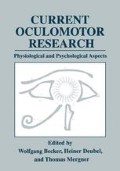Abstract
When updating the location of a visual object in space while moving around, we have to rely on sensory information from different modalities. Retinal signals provide us with a notion of the object’s position on the retina, but we also have to take into account eye position in the head and head position in space. In other words, we perform a coordinate transformation from a retinotopic reference frame via a craniotopic to a spatiotopic reference frame (e.g. Andersen et al. 1993). Human psychophysical studies indicate that these transformations show specific errors under certain conditions, from which we may learn how the brain performs these complex neuronal computations.
Access this chapter
Tax calculation will be finalised at checkout
Purchases are for personal use only
Preview
Unable to display preview. Download preview PDF.
References
Andersen RA, Snyder LH, Li CS, Stricanne B (1993) Coordinate transformations in the representation of spatial information. CurrOpin Neurobiol 3: 171–6
Bloomberg J, Melvill Jones G, Segal B, McFarlane S, Soul J (1988) Vestibular-contingent voluntary saccades based on cognitive estimates of remembered vestibular information. Adv Oto-Rhino-Laryngology 41: 71–75
Blouin J, Gauthier GM, van Donkelaar P, Vercher JL (1995a) Encoding the position of a flashed visual target after passive body rotations. Neuroreport 6: 1165–1168
Blouin J, Gauthier GM, Vercher JL (1995b) Failure to update the egocentric representation of the visual space through labyrinthine signal. Brain & Cognition 29: 1–22
Blouin J, Gauthier GM, Vercher JL (1997) Visual object localization through vestibular and neck inputs. 2: Updating off-mid-sagittal-plane target positions. J Vestib Res 7: 137–43
Bock O (1986) Contribution of retinal versus extraretinal signals towards visual localization in goal-directed movements. Exp Brain Res 64: 467–481
Bock O (1993) Localization of objects in the peripheral visual field. Behav Brain Res 56: 77–84
Fernandez C, Goldberg JM (1971) Physiology of peripheral neurons innervating semicircular canals of the squirrel monkey. II. Response to sinusoidal stimulation and dynamics of peripheral vestibular system. J Neuro-physiol 34: 661–75
Israel I, Berthoz A (1989) Contribution of the otoliths to the calculation of linear displacement. J Neurophysiol 62: 247–263
Maurer C, Kimmig H, Trefzer A, Mergner T. Visual object localization through vestibular and neck inputs. I. Localization with respect to space and relative to the head and trunk mid-saggital planes. J Vest Research 7:113–135,1997.
Mergner T, Hlavacka F, Schweigart G (1993) Interaction of vestibular and proprioceptive inputs for human self-motion perception. J Vest Res, 3: 41–57
Mergner T, Huber W, Becker W (1997) Vestibular-neck interaction and transformation of sensory coordinates. J Vestib Res 7: 347–367
Mergner T, Nasios G, Anastasopoulos D (1998) Vestibular memory-contingent saccades involve somatosensory input from the body support. NeuroReport 9: 1469–1473
Mergner T, Siebold C, Schweigart G, Becker W (1991) Human perception of horizontal trunk and head rotation in space during vestibular and neck stimulation. Exp Brain Res, 85: 389–404
Mergner T, Rottler G, Kimmig H, Becker W (1992) Role of vestibular and neck inputs for the perception of object motion in space. Exp Brain Res 89: 655–668
Nakamura T, Bronstein AM (1995) The perception of head and neck angular displacement in normal and labyrinthine-defective subjects. A quantitative study using a ‘remembered saccade’ technique. Brain 118: 1157–1168
Author information
Authors and Affiliations
Editor information
Editors and Affiliations
Rights and permissions
Copyright information
© 1999 Springer Science+Business Media New York
About this chapter
Cite this chapter
Nasios, G., Rumberger, A., Maurer, C., Mergner, T. (1999). Updating the Location of Visual Objects in Space Following Vestibular Stimulation. In: Becker, W., Deubel, H., Mergner, T. (eds) Current Oculomotor Research. Springer, Boston, MA. https://doi.org/10.1007/978-1-4757-3054-8_30
Download citation
DOI: https://doi.org/10.1007/978-1-4757-3054-8_30
Publisher Name: Springer, Boston, MA
Print ISBN: 978-1-4419-3308-9
Online ISBN: 978-1-4757-3054-8
eBook Packages: Springer Book Archive

